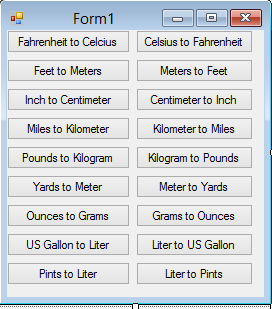Being a newbie can be hard sometimes, especially if your tasks involve Imperial to metric conversions. It has always baffled me as to why these types of tasks are common practice to programming lecturers and teachers.
I used to teach classes full time; now, I do on a part-time basis. I have always hated maths. To me, solving these types of equations on a student’s first day in the world of programming has always been stupid, to be frank.
Be that as it may, once you have grown as a programmer or even if you are a seasoned programmer, some formulas or calculations can become quite frustrating quite fast. I am not a maths guy, but I have encountered situations where I had to know a formula off-hand and quickly had to learn it.
The aim of this article is to help you with those stubborn niggling formulas that you might not know immediately. Let’s convert imperial to metric and vice versa!
Our Project
Open Visual Studio and create a new Visual Basic Windows Forms project. Once the project has been created, add 18 (eighteen) buttons to your form. My design looks like Figure 1:
Figure 1: Our design
| Note: All I will be covering with this article is the formulas. I will not try to overcomplicate them. |
Convert Fahrenheit to Celsius and Celsius to Fahrenheit
Add the following two functions and their implementations:
Function FahrenheitToCelsius(dblFahrenheit As Double) As Double
Return (dblFahrenheit - 32) * 5 / 9
End Function
Function CelsiusToFahrenheit(dblCelsius As Double) As Double
Return dblCelsius * 9 / 5 + 32
End Function
Private Sub Button1_Click(sender As Object, e As EventArgs) _
Handles Button1.Click
MessageBox.Show(FahrenheitToCelsius(95).ToString())
End Sub
Private Sub Button2_Click(sender As Object, e As EventArgs) _
Handles Button2.Click
MessageBox.Show(CelsiusToFahrenheit(35).ToString())
End Sub
Convert Feet to Metres and Metres to Feet
Add the functions and their implementations, as follows:
Function FeetToMeters(ByVal dblFeet As Double) As Double
Return dblFeet * 0.3048
End Function
Function MetersToFeet(ByVal dblMeters As Double) As Double
Return dblMeters / 0.3048
End Function
Private Sub Button3_Click(sender As Object, e As EventArgs) _
Handles Button3.Click
MessageBox.Show(FeetToMeters(132).ToString())
End Sub
Private Sub Button4_Click(sender As Object, e As EventArgs) _
Handles Button4.Click
MessageBox.Show(MetersToFeet(40).ToString())
End Sub
Convert Inches to Centimetres and Centimetres to Inches
Add the following code to convert inches to centimetres and centimetres to inches:
Function InchesToCentimeters(ByVal dblInches As Double) As Double
Return dblInches * 2.54
End Function
Function CentimetersToInches(ByVal dblCentimeters As Double) _
As Double
Return dblCentimeters / 2.54
End Function
Private Sub Button5_Click(sender As Object, e As EventArgs) _
Handles Button5.Click
MessageBox.Show(InchesToCentimeters(20).ToString())
End Sub
Private Sub Button6_Click(sender As Object, e As EventArgs) _
Handles Button6.Click
MessageBox.Show(CentimetersToInches(50).ToString())
End Sub
Convert Miles to Kilometres and Kilometres to Miles
Add the following code:
Function MilesToKilometers(ByVal dblMiles As Double) _
As Double
Return dblMiles * 1.6093
End Function
Function KilometersToMiles(ByVal dblKilometers As Double) _
As Double
Return dblKilometers / 1.6093
End Function
Private Sub Button7_Click(sender As Object, e As EventArgs) _
Handles Button7.Click
MessageBox.Show(MilesToKilometers(20).ToString())
End Sub
Private Sub Button8_Click(sender As Object, e As EventArgs) _
Handles Button8.Click
MessageBox.Show(KilometersToMiles(32).ToString())
End Sub
Convert Pounds to Kilograms and Kilograms to Pounds
Function PoundsToKilograms(ByVal dblPounds As Double) As Double
Return dblPounds * 0.4536
End Function
Function KilogramsToPounds(ByVal dblKilograms As Double) _
As Double
Return dblKilograms / 0.4536
End Function
Private Sub Button9_Click(sender As Object, e As EventArgs) _
Handles Button9.Click
MessageBox.Show(PoundsToKilograms(20).ToString())
End Sub
Private Sub Button10_Click(sender As Object, e As EventArgs) _
Handles Button10.Click
MessageBox.Show(KilogramsToPounds(9).ToString())
End Sub
Convert Yards to Meters and Meters to Yards
Function YardsToMeters(ByVal dblYards As Double) As Double
Return dblYards * 0.9144
End Function
Function MetersToYards(ByVal dblMeters As Double) As Double
Return dblMeters / 0.9144
End Function
Private Sub Button11_Click(sender As Object, e As EventArgs) _
Handles Button11.Click
MessageBox.Show(YardsToMeters(10).ToString())
End Sub
Private Sub Button12_Click(sender As Object, e As EventArgs) _
Handles Button12.Click
MessageBox.Show(MetersToYards(10).ToString())
End Sub
Convert Ounces to Grams and Grams to Ounces
Function OuncesToGrams(ByVal dblOunces As Double) As Double
Return dblOunces * 28.349
End Function
Function GramsToOunces(ByVal dblGrams As Double) As Double
Return dblGrams / 28.349
End Function
Private Sub Button13_Click(sender As Object, e As EventArgs) _
Handles Button13.Click
MessageBox.Show(OuncesToGrams(100).ToString())
End Sub
Private Sub Button14_Click(sender As Object, e As EventArgs) _
Handles Button14.Click
MessageBox.Show(GramsToOunces(100).ToString())
End Sub
Convert Imperial Gallons to Litres and Vice Versa
Function GallonsToLiters(ByVal dblGallons As Double) As Double
Return dblGallons * 3.785
End Function
Function LitersToGallons(ByVal dblLiters As Double) As Double
Return dblLiters / 3.785
End Function
Private Sub Button15_Click(sender As Object, e As EventArgs) _
Handles Button15.Click
MessageBox.Show(GallonsToLiters(50).ToString())
End Sub
Private Sub Button16_Click(sender As Object, e As EventArgs) _
Handles Button16.Click
MessageBox.Show(LitersToGallons(50).ToString())
End Sub
Convert Pints to Liters and Vice Versa
Function PintsToLiters(ByVal dblPints As Double) As Double
Return dblPints * 0.473
End Function
Function LitersToPints(ByVal dblLiters As Double) As Double
Return dblLiters / 2.113
End Function
Private Sub Button17_Click(sender As Object, e As EventArgs) _
Handles Button17.Click
MessageBox.Show(PintsToLiters(50).ToString())
End Sub
Private Sub Button18_Click(sender As Object, e As EventArgs) _
Handles Button18.Click
MessageBox.Show(LitersToPints(50).ToString())
End Sub
Conclusion
It is always good to have a few default formulas up your sleeve, just in case you forget them. I hope this list was useful to you. If you can think of more formulas that I may have left out, please do not hesitate to contact me.



